


 |
August 19-22: A Visit to Bangkok, Thailand |
 |
June 8-22: The San Francisco-Anchorage-Hawaii Triangle Trip |
 |
Return to Index for 1978 |
One of the sales I made recently was to Sunbeam Corporation, which purchased EDP-AUDITOR. We did an installation here in Chicago, and one in Milwaukee. Also, we worked with the System 3 package in Missouri. The most interesting thing about the Sunbeam sale, though, was that they wanted some training done in Australia- Sydney, to be exact. Even though I was nominally a sales guy, I prevailed on Jim Baker to let me go and do the training (since I'd done the Chicago and Milwaukee classes). I got scheduled for the class, and on August 12th I left Chicago for Sydney.
Traveling from Chicago to Sydney
|
I wasn't all that hungry since, as it turned out, United had served a dinner in coach on the flight to the West Coast. But the meal was good and I was pretty full when the Qantas flight left at 9PM. I suppose I should have checked, or perhaps Steve didn't print it on my itinerary, but because the flight to the Islands was five hours, Qantas served dinner on that flight as well, even though it left well after dinnertime. (I have since learned that most, if not all, overseas flights serve a meal no matter what time they leave.) Never one to turn down a meal, I consumed my third dinner.
We landed briefly in Hawaii, about midnight (Hawaii time), and then flew on to Sydney. Damned if Qantas didn't serve another complete meal after we left Honolulu! Chalk up my fourth dinner since leaving Chicago. There was some minor room to stretch out, but not much, so I mostly read and played a little backgammon until morning and our arrival in Australia. Of course, Qantas served a breakfast before we landed. This was my first experience with overseas travel except for London. It appears as if foreign carriers will serve a meal no matter what the time of day, as long as there is sufficient time to do so.
And there was definitely sufficient time. After our six-hour flight to the Islands from San Francisco, it was still another ten hours to Sydney; that's what I meant about these flights being so exhausting. (Try chewing up ten hours with none of today's electronic devices and games, and only a single inflight movie to watch.)
|
Australia was inhabited by indigenous Australians for about 60 centuries before the first British settlement in the late 18th century. In spite of earlier Dutch exploration, Australia's eastern half was claimed by Great Britain in 1770 and initially settled by prisoners beginning in 1788. The population grew steadily and by the 1850s most of the continent had been explored. On 1 January 1901, the six colonies federated, forming the Commonwealth of Australia. Australia has since maintained a stable liberal democratic political system comprising six states and ten territories.
At just under 3 million square miles, Australia is the oldest, flattest and driest inhabited continent, with the least fertile soils. Its size gives it a wide variety of landscapes, with deserts in the center, tropical rainforests in the northeast and mountain ranges in the southeast. And at just under 5 people per square mile, Australia's population density is among the lowest in the world. Australia generates its income from mining-related exports, telecommunications, banking and manufacturing. Culturally, its indigenous rock art is the oldest and richest in the world, dating to 60,000 BC and spread across hundreds of thousands of sites.
Australia has the world's 14th-largest economy with the world's tenth-highest per capita income. It is a regional power, with a large immigrant population, and it consistently ranks highly in quality of life, health, education, economic freedom, civil liberties and political rights, with all its major cities faring well in global comparative livability surveys.
This was the country where I was coming to work, and I would find that aside from the fact that Australians have a unique accent, there was little difference between Sydney and any modern American City.
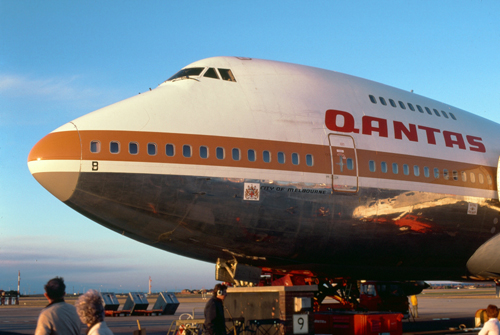 This is the 747 that I flew over on; I got this picture as I was walking from the gate to the terminal. |
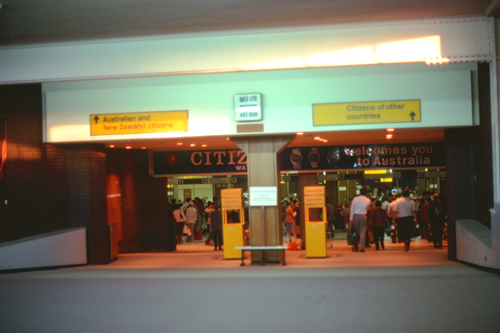 Click on the digital clock over the entrance to the arrivals hall and you'll see it's early in the morning. It's also Sunday, the 13th of July. |
It is also Winter, and the seasons have changed. It was quite warm when I left Chicago, but it was quite chilly here. And then there's the time change. I left Chicago about 3PM on Saturday afternoon, and my actual travel time, counting layovers, has been some 27 hours. But here it is only about 13 hours later- local time. I'm tired, but there is a full day ahead of me. I felt very disconcerted; while it was early in the morning, I felt as if I'd put in a full day and stayed up all night (which, in effect, I did). I was met by some of the Sunbeam personnel, and we drove into the city to the Sydney Hilton where I was staying. I mentioned the jet lag, and their advice was to force myself to stay awake all day long, and just go to bed early- like 8PM. Then, when they pick me up in the morning, I should be fine.
|
|
I was not aware until I arrived at the hotel and checked in that only five months earlier, the Hilton had been the site of one of the very few "terrorist" attacks suffered by Australia. On 13 February 1978, a bomb exploded outside the hotel, which was then the venue for the first Commonwealth Heads of Government Regional Meeting, a regional offshoot of the biennial meetings of the heads of government from across the Commonwealth of Nations. The bomb had been placed in a garbage bin outside the hotel, and it exploded when a collection truck emptied it at 1230AM. To garbage collectors and a security guard on duty nearby were killed. In the subsequent months and years, a number of unexplained aspects of the bombing fed a growing conspiracy theory about the event; few of these issues have been resolved.
Following the advice of the Sunbeam people who dropped me off at the Hilton, I spent just an hour or two in the hotel getting cleaned up from the long flight, and then I went out for the day to tour around the harbor area- which was within walking distance of the hotel.
|
Designed by a Danish architect, the building was formally opened on 20 October 1973, 16 years after the architect's selection in 1957 as the winner of an international design competition. Work on the buildings began in 1958, but the project was marred by cost overruns, scheduling extensions, as well as the architect's ultimate resignation.
The building and its surrounding facilities and parkland occupy the whole of Bennelong Point on Sydney Harbor, between Sydney Cove and Farm Cove, adjacent to the Sydney central business district and the Royal Botanic Gardens, and close by the Sydney Harbor Bridge.
Though its name suggests a single venue, the building comprises multiple performance spaces which together host well over 1,500 performances annually, attended by more than 1.2 million people. Performances are presented by numerous performing artists, including three resident companies: Opera Australia, the Sydney Theatre Company and the Sydney Symphony Orchestra. As one of the most popular visitor attractions in Australia, the site is visited by more than eight million people annually, and approximately 350,000 visitors take a guided tour of the building each year. The building is managed by the Sydney Opera House Trust, an agency of the New South Wales State Government.
|
The Sydney Harbor Bridge is a heritage-listed steel "through arch" bridge across Sydney Harbor that carries rail, vehicular, bicycle, and pedestrian traffic between the Sydney central business district and the North Shore. The dramatic view of the bridge, the harbour, and the nearby Sydney Opera House is an iconic image of Sydney, and of Australia itself. The bridge is nicknamed "The Coathanger" because of its arch-based design.
The bridge was designed and built by a British firm and opened in 1932. The bridge's design was influenced by the Hell Gate Bridge in New York City. It is the sixth longest spanning-arch bridge in the world and the tallest steel arch bridge (440 feet above water level). It is also the world's widest long-span bridge (160 feet). (Note: that title was taken in 2012 when the new Port Mann Bridge was constructed in Vancouver, Canada.) The Bridge is on Australia's National Heritage List.
I really enjoyed the boat ride. The day was warming up somewhat, but it was still only in the high 60s, and if there was any spray, it was decidedly chilly. There is a lot of activity in the Sydney Harbor, as one might think for such a large city, and the views from the boat were really impressive.
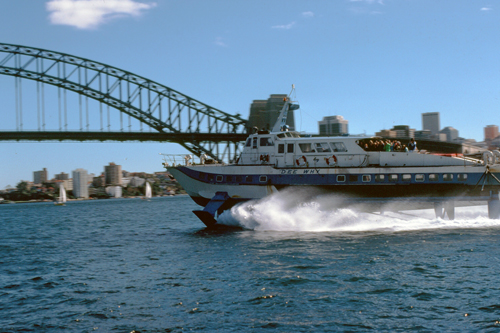 These are the hydrofoils that operate in the harbor. Sydney reminds me much of San Francisco- a city on hills near the ocean. |
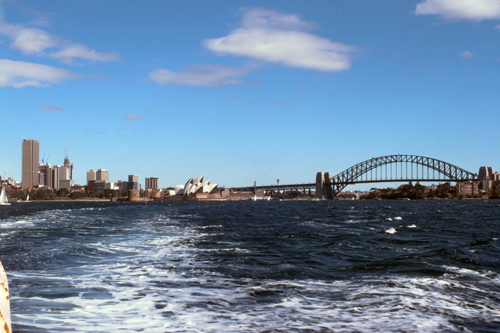 Looking back from the stern of the boat to the city of Sydney. |
It wasn't that I was enamored of visiting the zoo, but it was a good destination on the north side of the harbor for me to visit. And the boats and ferries utilized a dock adjacent to the zoo itself, so I didn't have to go far to get to it.
|
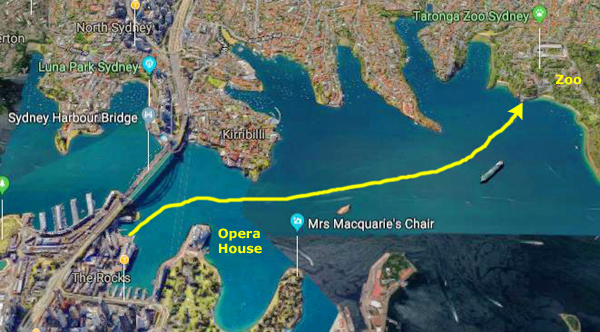 |
The Taronga Zoo Sydney is right on the north shore of Sydney Harbor. Officially opened in 1916, the zoo is managed by the Zoological Parks Board of New South Wales (the Taronga Conservation Society), along with its sister zoo, a larger one about ten miles west of here. The zoo is divided into eight zoogeographic regions, and the 69-acre facility is home to over 4,000 animals of 350 species. It has a zoo shop, a cafe, and information center.
|
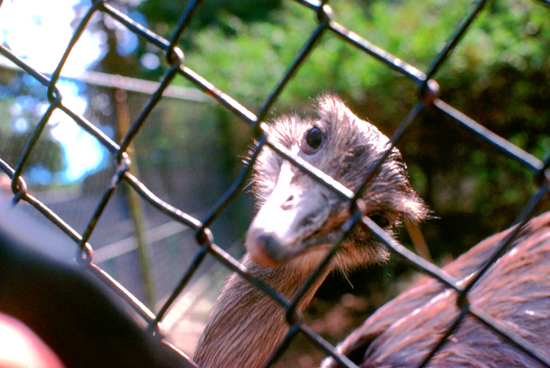 |
It goes without saying that I was actually looking around for some of Australia's national animal- the kangaroo- and they were certainly not hard to find. I learned that this marsupial (from a family of fauna whose taxonomic name means "large foot") is one of the few animals actually indigenous to Australia. While we might think they're cute, they have become a pest, and many millions of them roam the country, often causing traffic accidents. (The latest figures I found while writing this narrative were that it was estimated that in 2010, some 25 million kangaroos roamed the arable parts of the country, but that one year later that number had risen to 34 million. They must be incredibly prolific!)
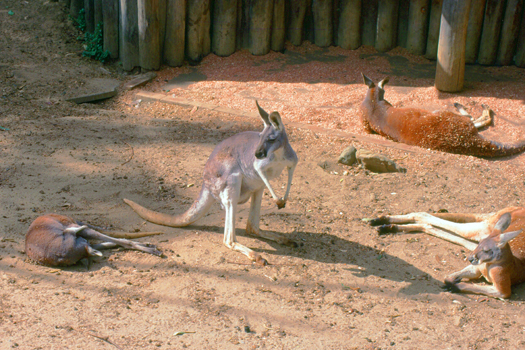 The zoo has lots of them (as does everywhere else in the country as well). |
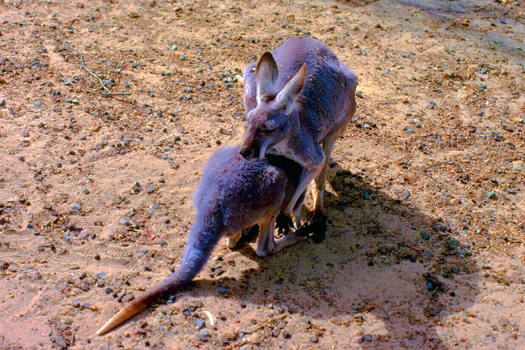 Australia's National Animal |
Walking around the zoo was really interesting, and I learned a few things. One was that "wallabies" are not a different animal, but, rather, are simply small kangaroos. And there's actually another term, "wallaroos", that refers to medium size animals. After visiting the zoo, and soaking up some of the bright afternoon sun, I went back to the zoo boat dock to catch a return craft.
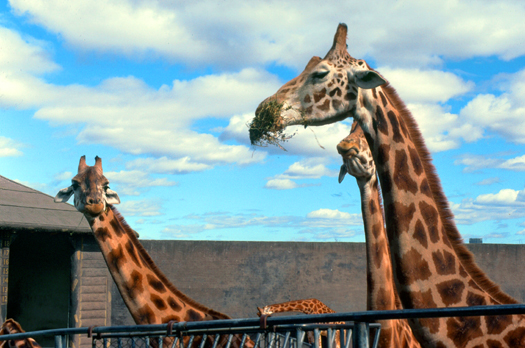 Not native to Australia, of course, are these giraffes. |
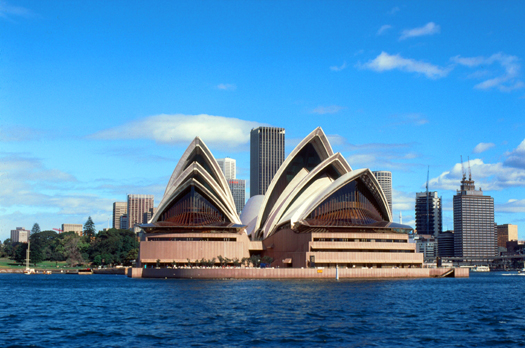 Taken on my return trip, here is a better view of the Sydney Opera House with the city as a backdrop. |
One interesting thing about my visit to Sydney was that Steve Goldberg, my travel agent, was at this same time on a familiarization trip through this part of the world, and we were able to make arrangements to meet one day during the week here in Sydney. We were able to have dinner together one night, and on another afternoon after I returned from work, go out and walk around downtown.
|
One interesting aspect of my work here was that I recall that I had a significant amount of difficulty installing our software on the computers that Sunbeam had in Sydney. Usually when that happens, I have to take my break times and lunch periods to call the office in Boston and talk to the technical people to try to solve the problem. This can easily consume all my free time during the day.
The problem here, though, was that at my break times and during lunch, being exactly half a world away from Boston, no one was in the office. So what I had to do was solve what problems I could, and then take the rest of them home with me to the hotel and, just before I went to sleep, about midnight, call the office in Boston. There, they were just coming in to work. After speaking to the technical guys and telling them about the problems, I would turn the light off and go to sleep.
When I woke up eight hours later, the people in the office were finishing for the day and they would call me back with the solutions. It was like having a time machine. For me, the problems were solved instantaneously, since I slept through the problem solving process. That way, I got the problem solved about as fast as usual, but didn't have to use up my free time during the day!
|
My impressions of Sydney were good, as I said, although the Winter weather deteriorated during the week. Members of the class and I went out a number of times. The transportation system is excellent, with a great number of trains, which I became fairly knowledgeable about riding to and from work. There was little of an Australian flavor, though. Sydney seemed like any city of its size, and the lack of difference was heightened by the fact that everyone spoke English, albeit with an accent, but definitely not British. (There was a wide variety in accents. Some folks did sound British, but most had that accent but with a nasal twang to it. This was subtle in most folks, but in others quite pronounced. The accent was not at all unpleasant, though, and I actually got to like it a great deal.)
People were also usually friendly, which was nice when I was trying to find my way around. Sadly, I wasn't in Sydney long enough to really get to know the city, and of course not in the country long enough to get to know it either. But then, on the other hand, if I were to stay in the country for a long time, my time would be spent instead out in the country, which is the part of Australia that is really interesting, so I am told. Getting to know Sydney well would be like getting to know Kansas City. Each big city that I have been to has its own attractions but, outside of the Orient, they have really been much the same.
So while I can say that I've been to Sydney and Australia, that's like saying I've been to Chicago because I changed planes at O'Hare. One of these days, I should return here to spend a week where I am not working 9 to 5; maybe then I can actually get to know this different and interesting place.
You can use the links below to continue to another photo album page.
 |
August 19-22: A Visit to Bangkok, Thailand |
 |
June 8-22: The San Francisco-Anchorage-Hawaii Triangle Trip |
 |
Return to Index for 1978 |